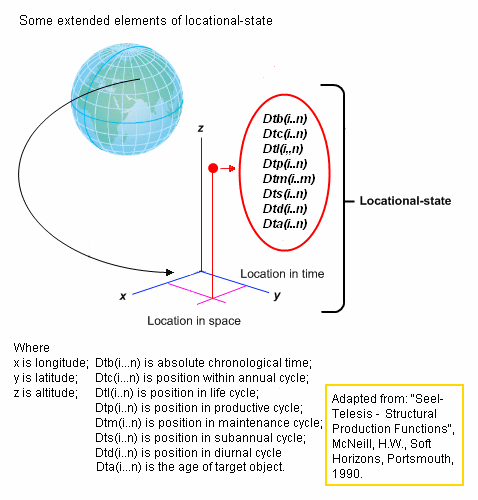 | ||||
 The initial step in explaining the logic of LS is to show why space-time coordinates qualify or determine the state of properties of an object. If we start with a plant as an example, it is a fact that plant genotypes have different levels of adaptation to different environmental conditions. Environmental conditions vary dramatically across the space-time dimension. As we move from the tropics to temperate zones the productivity and types of plants vary and in some locations, deserts and the polar caps, they cannot survive. In any specific region, if there is a hill or mountain, there is a roughly 0.6oC drop in temperature for every 100m gain in altitude. This has the effect of altering the timing of the stages of growth and reproduction observed for any naturally occurring plant genotypes according to where they might be located in a valley or mountain. These locational transitions are very well known in ecological work and in soil science (pedology) and are observed in the changes in soil texture and structure affecting water availability and fertility, generally known as a catena (the transition from a high elevation down into a valley, for example). The reference to plants located at different altitudes relates to naturally occurring genotypes so that the seeding, growth and flowering cycles would occur according to the ambient temperature conditions at the different altitudes. However, these natural locational-states can be altered by farmers planting a seedling before the time this would occur according to the normal reproductive cycle. The ability of the plant to grow at different locations is related to its genotype (DNS code) which can be altered as a result of plant breeding and selections. This results in the state of growth of that genotype being different from the others occurring naturally. The interesting point is that this does not "break up" the location-state theory because the differences observed can be explained in terms of the space-time dimension, that is, in terms of the specific age of the plant concerned, the time of planting and its location. Therefore the cumulative impact of space-time can be recognized in the hierarchy of natural cycles of ever shortening duration that have a direct influence the properties of a plant in particular or a large range of other objects (see diagram right). One of the interesting facts behind Charles Darwin's theory of evolution was that he first became interested in "change" after reading texts on geology and later observing the transition in geological formations associated with their age. Moving away from the natural world we know that an automobile of a specific age will survive in operational condition according to its environment represented by the levels of maintenance, the skills of the driver and general treatment of the vehicle. Locational-state logic has a wide application in statistical analysis across many domains. Starting out as a "method of dimensions" to create "tight" specifications of information requirements, Locational-State has slowly developed as an approach which has gradually uncovered a sound theoretical foundation. Euclid, Alfred Korzybski, Minkowski and others have produced theoretical and applicable perspectives in physics and other spheres where space-time is expressed as a 4D model. However, there is an urgent need to model physical objects and their relationship to the environment within which they exist in an understandable transparent fashion so as to draw useful conclusions. For this there is a need for a more mundane
Several, relatively recent developments have helped place Locational-State in a context of increasing relevance as well as helping it become a combination of robust theory and practical utility. These are the works of George Boole in his development of a mathematical logic designed to explain how individuals deduce (The Laws of Thought published 1854) based on experience of events (probabilities) and relationships (determinants). Claude Elwood Shannon, whose 1938 paper, "A Symbolic Analysis of Relay and Switching Circuits" explained how Boolean Logic and the process of Boolean reduction could contribute to a more efficient circuit design. This seminal work launched Boolean logic into the digital world. In the digital world, as early as 1960s, Kristen Nygaard and Ole-Johan2 became concerned with representation of heterogeneity, that is, to be able to describe and simulate reality. They developed Object Oriented Logic to address this issue and used this to build the SIMULA series of computational simulation programs. Ronald Howard, of Stanford University, also in the 1960s, coined the term decision analysis and created a strict dependency between the quality of determinant models, information or data quality and the probability of events resuscitating the fusion between George Boole's concern with experience and "what happens" with probabilities and questioning (decision trees) to refine the quality of information relied upon to deduce and take decisions. Roger Kaufman related systems operations design and objectives to user or constituency needs based on a broader consideration of the sustainability of the system (our world) while relating this to the details of the processes used by economic and social constituents. What is lacking, quite often, are comprehensive descriptors and analytical methods that can be used to make a more effective decision analysis simulation models based on Object Oriented Logic and that integrate systems sustainability; locational-state theory has a major contribution to make in this area. 1 According to McNeill, the locational-state imperative (LSI) is the essential qualification of an object property in terms of its formative history and current environment and ecosystem. All phenomena are subject to this qualification. Data that lacks effective locational-state qualifiers is of a deficient quality. The LSI is an essential qualifier in relation to living organisms including people and relevant to agricultural production, biomedical spheres, natural ecosystems and biodiversity. 2 Object Oriented Logic (OOL) was developed as a way to program computers with a programming logic known as object oriented programming (OOP). This was first developed in the 1960s by Kristen Nygaard and Ole-Johan and who until their deaths worked at the Department of Informatics at the University of Oslo, Norway. Their objective was to address the problem of simulating reality when reality is characterized by heterogeneity. This they achieved with the simulation program SIMULA the first object oriented program in the early 1960s. In agriculture, one of the most complex heterogeneous systems in the economy, the best approach to the identification of essential data for policy making is to deploy OOL. This is a rational approach since the relationships between critical variable elements of OOL is Boolean Logic which is the mathematical logic of how humans analyse and deduce. This is based on known cause and effect relationships, recent experience and access to information and our view of the probabilities of events. These are the basic factors deployed in human decision analysis
|